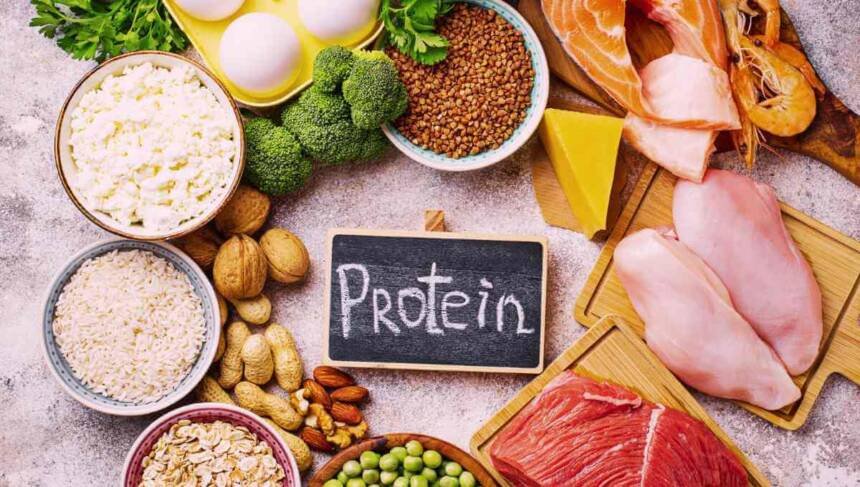If you want to be alert, full, and focused by lunchtime, the best thing to eat is a high-protein breakfast. Protein is an important nutrient that helps your body make enzymes and hormones, fix and build tissues, and keep you moving all day.
Most experts say that you should eat about 0.8 grams of protein per kilogram of body weight every day. However, some say that you should eat more, especially in the morning, to speed up your metabolism.
A nutrition professor at the University of Illinois named Donald Keith Layman says that eating a breakfast with at least 30 grams of protein can help you control your hunger, speed up your metabolism, and build and repair muscles.
Start your day off right with one of these 13 tasty breakfasts that are high in protein.
1. Eggs
Eggs are a great natural way to get protein and make a great breakfast food. There are about 6 grams of protein in a big egg.
- So many things you can do with it! Fry, roast, bake, boil, or make omelettes.
- You can add cheese, ham, turkey, veggies, or both to make it healthier and taste better.
- The Harvard Chan School of Public Health says that eggs are a good way to start the day because they are high in protein.
2. Greek Yogurt
Because most of the sugar and liquid are taken out, a 7-ounce amount of Greek yogurt usually has about 20 grams of protein.
- Find ones that are plain, low in fat, and don’t have a lot of extra sugar.
- You can sprinkle some cinnamon, nuts, seeds, or fresh berries on top.
- For an extra boost, add some whole grain toast or oats.
3. Cottage Cheese
One cup of low-fat cottage cheese has about 28 grams of protein, so don’t forget about this simple dairy product!
- You can eat it plain or mix it with nuts or fresh fruit.
- Stack layers of cheese, nuts, and crunchy high-protein cereals to make a breakfast parfait.
4. Protein Smoothies
The first thing is that smoothies are a very simple and flexible way to get protein.
- As a source for protein, you can use Greek yogurt, cottage cheese, protein powder, nut butters, or silken tofu.
- Just add some cold vegetables, fruits, and fiber-rich foods like chia seeds, oats, or green vegetables.
- The American Council on Exercise says that to help your muscles heal, you should mix some protein powder into your milk or milk substitute.
5. Tofu Scramble
You can make tofu scramble if you want a flexible and tasty plant-based choice.
- One cup of hard tofu has about 20 grams of protein.
- To cook tofu, add veggies like onions, peppers, and spinach and roast them.
- For a “egg” taste, just add some spices and nutritional yeast.
6. Protein Oatmeal
Oats are a great whole grain because they give you fiber, protein, and other good things for you. Do you want even more protein?
- Using milk or a milk substitute instead of water to make oatmeal.
- Egg whites, Greek yogurt, nut butters, or cottage cheese can all be added.
- You can put nuts, seeds, or granola on top.
7. Protein Pancakes or Waffles
Would you like some pancakes or waffles with protein?
- Mix things up a bit with this standard breakfast dish by adding protein powder or other high-protein foods.
- To the mix, you can just add protein powder, eggs, nut butters, or Greek yogurt.
- You can also add nuts, fresh fruit, nut butter, or Greek yogurt around the edges.
8. Breakfast Burrito
A whole wheat tortilla with something inside it.
- Eggs fried
- Which would you like more: black beans or pinto beans?
- Salsa, avocado, and greens
- Add some cheese for extra nutrition and creaminess.
9. Porridge made with quinoa
Quinoa is a very healthy pseudo-grain that is full of protein.
- Adding milk or a milk substitute to quinoa while cooking it makes a warm and creamy breakfast.
- You can pick any protein powder, nuts, seeds, veggies, or nut butters you like.
10. Smoked salmon
Bagels are a quick and filling way to start the day.
- Smoked salmon can be put on toast or whole-grain bread.
- You can add chopped tomatoes, olives, red onion, and cream cheese if you want to.
- More than 20 grams of protein are in a small piece of salmon.
11. Protein Overnight Oats Mix old-fashioned oats with:
- Greek yogurt or milk
- Protein powder
- Nut butters
- Fresh or frozen fruit
- Let it soak overnight for an easy, protein-packed grab-and-go breakfast.
12. Breakfast Chili
This savory option will keep you full all morning.
- Combine lean ground turkey or beef with beans, tomatoes, onions, and spices.
- Top with Greek yogurt, avocado, cheese, and your other favorite chili toppings.
13. High-Protein Veggie Frittata
Frittatas are crustless quiches packed with protein from eggs.
- Fill with veggies like broccoli, mushrooms, peppers, onions, tomatoes, and spinach.
- Add cheese, turkey bacon, ham, smoked salmon, or tofu for extra protein.
Protein Tips and Strategies
To maximize the benefits of your high protein breakfast, keep these expert tips in mind:
“Consuming 20-30 grams of protein at each meal can curb appetite, improve muscle growth and recovery, and promote overall metabolic health,” says Dr. Paul Arciero, professor at Skidmore College and president of the PRISE (Protein-paced, Resistance, Interdisciplinary, Synergistic Exercise) institute.
If you struggle to consume enough protein in the morning, try mixing protein powder into smoothies, oatmeal, yogurt, or baked goods. Look for varieties without excessive sugar or artificial sweeteners.
According to NYC’s Registered Dietitian Rebecca Ditkoff, “Getting protein first thing in the morning is ideal as research shows that it helps control hunger and cravings throughout the day.”
Don’t forget to pair your breakfast with fiber from whole grains, fruits, and veggies to feel fuller longer and stabilize blood sugar levels.
Frequently Ask Questions
What are the benefits of a high protein breakfast?
A breakfast high in protein is great because it gives you energy that lasts longer, helps you focus better, keeps you from wanting too much later on, heals and builds muscle, and even speeds up your metabolism.
How much protein should I aim for at breakfast?
Many experts say that the best way to get the most out of protein is to eat 20 to 30 grams of it for breakfast. Please remember that everyone has different needs based on their age, level of activity, and weight loss or gain goals.
Are plant-based or animal-based proteins better for breakfast?
For breakfast, you can eat either plant or animal energy. Plant-based foods like nuts, seeds, and soy are great. Protein-rich foods like eggs, cheese, and lean meats are also great.
Can eating too much protein at breakfast be harmful?
Having a breakfast high in protein is fine and may even be good for you if you’re fit. What if you have kidney problems, though? You might want to cut back on protein and talk to your doctor about it.
What are some creative ways to add more protein to breakfast?
You can make your food more interesting by adding protein powder to oatmeal, smoothies, or pancake mix. When you make breakfast, don’t be afraid to add nut butters, seeds, rice, lentils, or tofu.
How can I make high protein breakfasts more appealing for picky eaters?
Try experimenting with different looks, tastes, and textures. You could make pancakes with cool toppings that are high in protein, or you could make a smoothie with their favorite fruits and spices.
Are there any specific types of protein that are better for breakfast?
For the most health benefits, some experts say to eat less prepared protein sources like eggs, Greek yogurt, cheese, and lean meat.
Can a high protein breakfast help with weight management?
Some research has shown that eating a high-protein breakfast in the morning can help you eat fewer calories during the day, keep you full, and speed up your metabolism. All of these things can help you control your weight.
How can I make high protein breakfasts more convenient for busy mornings?
Get your things ready ahead of time, like making protein shake packs, hard-boiled eggs, or overnight oats. You could also have Greek yogurt, nut butter packets, and energy bars on hand that are easy to carry.
Are there any specific health conditions where a high protein breakfast may be particularly beneficial?
A breakfast high in protein might be good for busy people, older adults who want to keep their muscles, people on a low-carb or ketogenic diet, and people who have trouble controlling their blood sugar.




